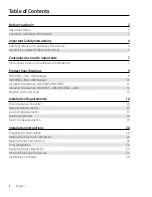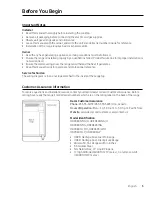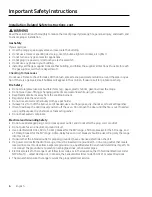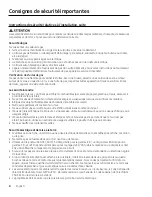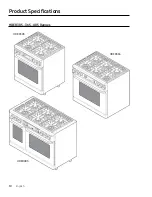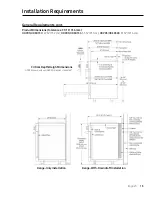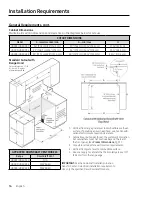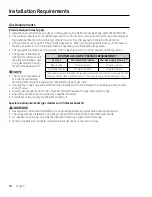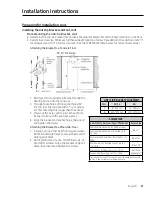
6
English
Important Safety Instructions
Installation-Related Safety Instructions, cont.
Read these instructions thoroughly to reduce the risk of property damage, fire, personal injury, and death, and
to ensure proper installation.
Gas Safety
If you smell gas:
• close the range's gas-supply valve and evacuate the building
•
do not use a flame or sparking device (e.g., match, butane lighter or clicker, arc lighter)
• do not turn on any gas or electric appliances
• do not plug in a power cord or touch an electrical switch
• do not use any phone in your building
•
instantly call the gas supplier from another building, and follow the supplier’s directions (if unable to reach
the gas supplier, call the fire department).
Checking For Gas Leaks
Do not use a flame to check for leaks. With a brush, spread a soap-and-water solution around the area in ques
-
tion. If there is a gas leak, small bubbles will appear in the solution. If unsure, call for professional help.
Fire Safety
•
Do not store/place/use combustible items (e.g., paper, plastic, fabrics, gasoline) near the range.
•
Do not wear loose-fitting or hanging garments or accessories while using the range.
•
Keep flammable items away from the cooktop burners.
• Regularly clean the oven vents.
• Do not use a towel or other bulky cloth as a pot holder.
•
(Grease fires) Turn off the burner, and if needed, use a multi-purpose, dry-chemical, or foam extinguisher.
•
(Oven fires) Keep the door closed, and turn off the oven. Do not open the door until the fire is out. If needed,
use a multipurpose, dry-chemical, or foam extinguisher.
• Do not heat sealed containers.
Electrical and Grounding Safety
• Do not use a damaged plug, cord, or loose power outlet, and do not alter the plug, cord, or outlet.
• Do not put a fuse in a neutral or ground circuit.
•
Use a dedicated 240 Vac, 60 Hz, 50 Amp breaker for the 48” range, a 30 Amp breaker for the 36” range, and
a 30 Amp breaker for the 30" range. A time-delay fuse or circuit breaker should be used. Plug only the range
into this circuit.
• If unsure that the intended outlet is properly grounded, have a licensed electrician check it.
•
If a power cord is attached to the range, it must be inserted in a grounded, 3- or 4-prong outlet that meets
local ordinances. If codes allow a separate ground wire, a qualified electrician should determine its path. Do
not connect the ground wire to plastic plumbing/gas lines, or hot-water pipes.
•
Electrical service to the range must follow local codes, or in their absence, the US National Electrical code/
NFPA No. 70 – Latest Revision or, in Canada, the Canadian Electrical Code CSA C22.1 or Latest Revisions.
• The owner shall ensure the range receives the proper electrical service.


